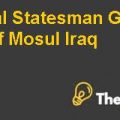What are Airtel’s growth prospects? Is organic growth the right path for a company, or should the company stick to organic growth for long-term success?
It can be evaluated that, due to the increase in the number of competitors and their competitive attitudes in the market,it would be very difficult for Airtel to gain and maintain a significant portion of the market share, without making significant efficient investments in their capital assets, which would enhance their asset turnover ratios. However, it can be determined that, the company could ensure its survival and growth in the market, if it decided to efficiently invest in capital investments, enhancing their economies of scale and profitability. Furthermore, it can be evaluated from the case that, Airtel should focus on organic growth instead of inorganic growth. The organic growth strategy would enable the company to decrease its incurred debt to acquire or merge with established organizations in the market locally or overseas. The organic growth strategy focusses on business expansion through increased output or customer base. Additionally, it also focusses on expansion through new product development, which would enable the company to expand organically in the market through higher returns generated from its new product development or enhanced outputs. Therefore, it can be determined that, organic growth would be more beneficial for the company, instead of inorganic growth achieved through the merger or acquisition of companies available in the market. This would expose the company to higher debt to equity ratios. Moreover, Airtel’s dependence on profits generated from its inorganic investments financed through borrowing would be significantly increased, incurring higher interest rates. Where, if the inorganic investments didn’t pan-out as planned by the management, the company would be exposed to payment defaults with respect of its loan payments. Credibility of the company would be decreased among lenders and its ability to ensure its going concern in the market would be compromised, attributed to its inability to pay-off the debt acquired to finance the inorganic investment.
Identify FOUR areas that need improvement for the company’s future growth?
After analyzing the case, the areas that need improvement could be identified for the future growth of the company, illustrated below:
- The first problem area identified relates to the company’s investment financing policy, which it had acquired through significant financing from international markets in the form of loans to support its inorganic investments, incurring higher interest rates.This could have significant adverse impacts on the organization’s future growth prospects, if its inorganic investments were faced with systematic market volatility and suffered its impact. It would compromise its ability to pay-off its loans, resulting in liquidation and dissolution of the company and its shares in the market.
- The Second problem area identified relates to the management’s ability to efficiently use its current capital assets towards generating required rate of returns. It can be assessed that, the assets turnover ratio of the company had decreased from 1.20 in 2010 to 1.03 in 2013,which could be attributed to management’s inability to effectively allocate its capital resources in the right place that would result in generating higher returns. Therefore, it can be evaluated that, Airtel should employ or effectively train expert staff to make key business decisions regarding capital assets available to the company, increasing their profit potential and better positing the company in the market, while enabling them to secure a sufficient share in the market.
- The third problem area identified relates to quality service consistency. The company lacks in providing consistent quality service to its customers over time. This resulted towards decreasing profitability, despite extensive capital investments. Due to which, the customers were moving towards its competitors. Hence, it was evaluated that, the competitors were cannibalizing the revenues and profitability of Airtel.
- The fourth problem area identified is related to its leadership. There had been various change in its upper executive employees such as, Sanjay Kapoor was promoted to CEO of the company and Manoj Kohli, who was the CEO and joint managing director of its Indian segment was made MD and CEO of its newly formed international business division. However, it can be assessed that these kind of abrupt changes in leadership roles cannot be good for the morale of the employee. The employee would be demotivated and questions could be raised about their job security. Furthermore, the abrupt changes in leadership could also raise questions regarding the future policies and strategic direction of the company, simultaneously decreasing the confidence of the stakeholders in the future growth prospect of the company.
Exhibit
| Free Cash flows | ||||||
| 2010 | 2011 | 2012 | 2013 | 2014 | 2015 | |
| PAT | 94,260 | 77,161 | 57,300 | 50,960 | 88,215 | 95,626 |
| Add: Depreciation | 38,900 | 41,931 | 59,160 | 68,261 | 62,957 | 68,246 |
| Less: Capital Expenditure | 28,487 | 30,412 | 33,282 | 36,280 | 39,328 | 42,632 |
| FCF | 104,673 | 88,680 | 83,178 | 82,941 | 111,844 | 121,240 |
| WACC | 12% | |||||
| Initial Investment | (250,000) | |||||
| NPV | $134,781 | |||||
| IRR | 31% |
This is just a sample partical work. Please place the order on the website to get your own originally done case solution.













